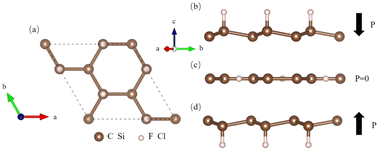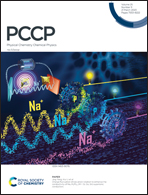A first-principles study on the multiferroicity of semi-modified X2M (X = C, Si; M = F, Cl) monolayers
Abstract
The research of two-dimensional multiferroic materials has attracted extensive attention in recent years. In this work, we systematically investigated the multiferroic properties of semi-fluorinated and semi-chlorinated graphene and silylene X2M (X = C, Si; M = F, Cl) monolayers under strain using first principles calculations based on density functional theory. We find that the X2M monolayer has a frustrated antiferromagnetic order, and a large polarization with a high reversal potential barrier. When increasing the applied biaxial tensile strain, the magnetic order remains unchanged, but the polarization flipping potential barrier of X2M gradually decreases. When the strain increases to 35%, although the energy required to flip the fluorine and chlorine atoms is still very high in the C2F and C2Cl monolayers, it goes down to 312.5 meV and 260 meV in unit cells of the Si2F and Si2Cl monolayers, respectively. At the same time, both semi-modified silylenes exhibit metallic ferroelectricity with a band gap of at least 0.275 eV in the direction perpendicular to the plane. The results of these studies show that Si2F and Si2Cl monolayers may become a new generation of information storage materials with magnetoelectric multifunctional properties.



 Please wait while we load your content...
Please wait while we load your content...